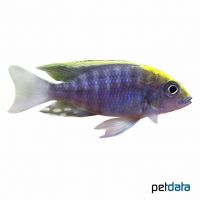Sulphurhead Peacock (Aulonocara maylandi)
| Sulphurhead Peacock Aulonocara maylandi | |
|---|---|
| Name | Sulphurhead Peacock |
| Name Lat. | Aulonocara maylandi |
| Family | Cichlids |
| Family lat. | Cichlidae |
| Order | Cichlids |
| Order lat. | Cichliformes |
| Origin | Lake Malawi |
| Habitat | Intermediate zone |
| Diet | Carnivore |
| pH | 7.5-8.8 |
| Behavior | Peaceful |
| Keeping | Harem |
| Care Level | Moderate |
| Reproduction | Mouthbrooder |
| Breeding | Simple |
| Life Span | 6-10 years |
| Protection | No |
| Metric Units | |
| Size | 10-12 cm |
| Temperature | 24-28 °C |
| Hardness | 10-25 °dH |
| Aquarium | ~ 300 l |
| US Units | |
| Size | 4"-5" |
| Temperature | 75-82 °F |
| Hardness | 178-445 ppm |
| Aquarium | ~ 80 gal |
Distribution and habitat
Sulphurhead emperor cichlids are found exclusively (endemically) at Chimwalani Reef (Eccles Reef) in southeastern Lake Malawi. They belong to the group of rock Aulonocara, which mostly live in the rock-sand transition zone in 10-15 m water depth.
Maintenance
The aquarium setup should have rock structures reaching to the water surface, with plenty of crevices, caves and shelters to provide hiding places, and a light colored substrate with plenty of open sandy areas.
No ammonia, ammonium or nitrite should be detectable, and the nitrate value should not exceed 100 mg/l. To ensure the water quality and the oxygen content, a filter adapted to the aquarium size and a heater are required, as well as lighting for the species-appropriate day-night rhythm of the animals.
Diet
In the wild they feed mainly on insect larvae and small crustaceans living in the sand. The food supply consists of live, frozen and dry food. For a balanced diet, feed once a day with a high-quality, protein-rich dry food for cichlids (flakes, granules, pellets) as well as daphnia, Artemia mysis, mosquito larvae, etc. (live or frozen).
It is recommended to feed small portions several times a day. Only feed as much as will be eaten within a few minutes. A regular and varied diet promotes health and increases resistance.
Behaviour and compatibility
They should be kept in a harem, one male with several females. Males behave intra-species territorial, so keeping several harems is only recommended in a larger and richly structured tank. With their calm temperament they belong to the peaceful Malawi cichlids and should only be socialized with other peaceful Malawi cichlids.
Basically, only compatible fish species with similar demands on water conditions and water temperature should be socialized.
Sex dimorphism
The male is much more colorful than the female (sexual dichromatism) and has longer extended fins. The female is usually smaller and inconspicuous silver-gray colored.
Reproduction and breeding
They are maternal mouth brooders. Immediately after spawning on a rock, the females take the eggs into their throat sac for mouth brooding. They keep the fry in their throat sac even after hatching. After about 3 weeks, the fry are released and brood care ends. During the entire brood care, the female does not take any food.
Fry must be fed several times a day with special rearing food. In a community tank breeding is hardly possible, because the fry are easy prey.
Important
Characteristic of Aulonocara are many small funnel-shaped depressions (sensory pits) mainly on the underside of the head, which are used for foraging in the sandy substrate
Only one Aulonocara species should be kept in a tank, as the animals may interbreed.
The well-being of the fish should be checked regularly. The temperature should be checked daily, the pH, hardness and nitrate value at least every 14 days. Regular partial water changes are recommended, even if the contaminant level has not yet reached the upper limit. Sudden changes in water quality should be avoided. Newly introduced fish must be accustomed slowly to the water in the aquarium.
Further literature can be found in your pet store.
References
Text: Sylvia Hos; Image: petdata
Source: BMELV (1998): Tierschutzgutachten - Haltung von Zierfischen (Süßwasser); BAENSCH & RIEHL (2004): Aquarien Atlas Bd. 2, Mergus Verlag; ENGELMANN (2005): Zootierhaltung - Tiere in menschlicher Obhut: Fische, Verlag Harri Deutsch
- Gemäß § 21 Abs. 5 Tierschutzgesetz idgF
